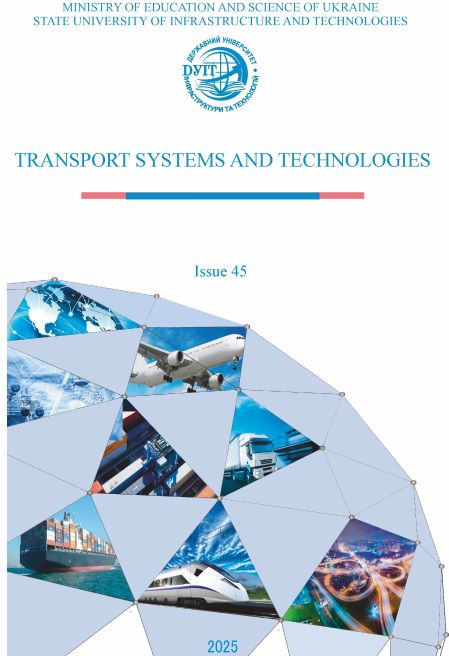Study of the ınfluence of coordınated regulatıon on the traffıc flow parameters on ıntersectıng streets
Keywords:
coordinated regulation, traffic flow, traffic parameters, delay, intersection, modeling, PTV VISSIMAbstract
The article studies the nature of changes in traffic flow parameters on the intersecting streets when using coordinated regulation to organize uninterrupted traffic on city highways. The influence of the "green wave" mode on the traffic flow parameters is analyzed. Traffic delays on intersecting streets were compared before and after the implementation of coordinated regulation. Traffic delay values at intersections were determined and analyzed in a comparative manner using the Webster and HCM 2010 methodology and simulation tests. Measurements were carried out based on real values (speed and traffic intensity on sections) taken at 7 intersections of the street network of the city of Baku. For simulation tests, a coordinated regulation model built in the PTV VISSIM program was used. Using the created micromodel, the results of the impact of the implementation of coordinated regulation on traffic delays on main and intersecting streets were tested. The total time losses on the street where the "green wave" is implemented and on intersecting streets were estimated for the options before and after the coordination of traffic light modes. Based on the values determined by all three methods, it was found that after the implementation of coordinated regulation on the main street the delay time of vehicles increases on intersecting streets. The proposed approach can help to evaluate the effectiveness of coordinated regulation in terms of time losses before its implementation on city streets.
References
Li, W., & Tarko, A. P. (2011). Effect of arterial signal coordination on safety. Transportation research record, 2237(1), 51-59. https://doi.org/10.3141/2237-06.
Yue, R., Yang, G., Zheng, Y., Tian, Y., & Tian, Z. (2022). Effects of traffic signal coordination on the safety performance of urban arterials. Computational Urban Science, 2(1), 3. https://doi.org/10.1007/s43762-021-00029-4.
Kabir, R., Remias, S. M., Lavrenz, S. M., & Waddell, J. (2021). Assessing the impact of traffic signal performance on crash frequency for signalized intersections along urban arterials: A random parameter modeling approach. Accident Analysis & Prevention, 149, 105868. https://doi.org/10.1016/j.aap.2020.105868.
Abdulstaar, Z.A. (2023). Effect of Signal Coordination on The Traffic Operation of Urban Corridor. Tikrit Journal of Engineering Sciences, 30(1),12-24. https://doi.org/10.25130/tjes.30.1.2.
Fabian, P., Čulík, K., Kalašová, A., & Černický, Ľ. (2024). The Impact of Road Realignment on the Traffic Load in the Surrounding Area. Vehicles, 6(4), 1942-1962. https://doi.org/10.3390/vehicles6040095.
Yu, C., Chen, J., & Xia, G. (2022). Coordinated control of intelligent fuzzy traffic signal based on edge computing distribution. Sensors, 22(16), 5953. https://doi.org/10.3390/s22165953.
Rida N., Ouadoud, M., &Hasbi, A. (2020). Coordinated Signal Control System in Urban Road Network. İnternational journal of Online and biomedical Engineering, 16(10), 1-19. https://doi.org/10.3991/ijoe.v16i10.15473.
Liu, Y., & Song, Y. (2022). Research on simulation and optimization of road traffic flow based on Anylogic. In E3S Web of Conferences (Vol. 360, p. 01070). EDP Sciences. https://doi.org/10.1051/e3sconf/202236001070.
Kazmi, S. M. M., Sun, X., Yu, H., Pettersen, J. A., & Thordarson, D. S. (2022). Proceedıng of the 32nd conference of fruct assocıatıon. (р. 369-365). https://fruct.org/publications/volume-32/acm32/.
Dashdamirov, F., Aliyev, A., Verdiyev, T., & Javadli, U. (2023, June). Improving Intersection Traffic Management Solutions by Means of Simulation: Case Study. In Recent Developments and the New Directions of Research, Foundations, and Applications: Selected Papers of the 8th World Conference on Soft Computing, February 03–05, 2022, Baku, Azerbaijan, Vol. II (pp. 279-286). Cham: Springer Nature Switzerland. https://doi.org/10.1007/978-3-031-23476-7_25.
Benčat, G., & Janota, A. (2020). Road traffic modelling based on the hybrid modelling tool AnyLogic. Journal of civil engineering and transport, 2(2), 73-89. https://doi.org/10.24136/tren.2020.006.
Suthanaya, P. A., & Putra, R. (2023). Traffic signal coordination based on VISSIM software (case study of Sudirman road in Denpasar city, Indonesia). In E3S Web of Conferences (Vol. 445, p. 01004). EDP Sciences. https://doi.org/10.1051/e3sconf/202344501004.
Rida, N., & Hasbi, A. (2022). A collaborative road traffic regulation approach using a wireless sensor network. International Journal of Service Science, Management, Engineering, and Technology (IJSSMET), 13(1), 1-19. https://doi.org/10.4018/IJSSMET.290330.
Kumar, R. P., & Dhinakaran, G. (2012). Estimation of delay at signalized intersections for mixed traffic conditions of a developing country. International journal of civil engineering, 11(1). 53-59. http://ijce.iust.ac.ir/article-1-595-en.html.
Huang, J., Li, G., Wang, Q., & Yu, H. (2013, November). Real time delay estimation for signalized intersection using transit vehicle positioning data. In 2013 13th International Conference on ITS Telecommunications (ITST) (pp. 216-221). IEEE. https://doi.org/10.1109/ITST.2013.6685548.
Ramesh, A., & Molugaram, K. (2018). Evaluation of delay characteristics at signalized intersections for improvement in level of service. International journal for traffic and transport engineering, 8(3), 309-319. http://dx.doi.org/10.7708/ijtte.2018.8(3).05.
Wasiu, J., Owolabi, A., & Popoola, O. (2015). Determination of Traffic Delay at Selected Intersection within Ilorin Metropolis. American Journal of Engineering Research (AJER), 4(9), 176-180.
Roy, B., Suma, S. A., Hadiuzzaman, M. D., Barua, S., & Mashrur, S. K. (2021). Optimization of Delay Time at Signalized Intersections Using Direction-Wise Dynamic PCE Value. International Journal of Transportation Engineering, 8(3), 279-298. https://doi.org/10.22119/ijte.2020.225672.1514.
Knoop, V. L. (2021). Traffic Flow Theory: An Introduction with Exercises. TU Delft OPEN Publishing. https://doi.org/10.5074/t.2021.002.
Webster, F.V. (1958). Traffic Signal Settings. Department of Scientific and Industrial Research, Road Research Technical Paper No. 39. Her Majesty's Stationary Office, London, England. https://trid.trb.org/View/113579.
Hoque, S., & Imran, A. (2007). Modification of Webster’s delay formula under non-lane based heterogeneous road traffic condition. Journal of Civil Engineering, 35(2), 81-92.
Raval, N. G., & Gundaliya, P. J. (2012). Modification of Webster's delay formula using modified saturation flow model for non-lane based heterogeneous traffic condition. Highway Research Journal, 5(1), 41-48.
Manual, H. C. (2000). Highway capacity manual. Washington, DC, 2(1), 26-27. https://onlinepubs.trb.org/Onlinepubs/trnews/rpo/rpo.trn129.pdf.
Akkaya, S., & Engin, T. (2022). Traffic simulation software overview. Akıllı Ulaşım Sistemleri ve Uygulamaları Dergisi, 5(2), 157-168. https://doi.org/10.51513/jitsa.1090209. [in Turkish].
Qadri, S. S. S. M., Gökçe, M. A., & Öner, E. (2020). State-of-art review of traffic signal control methods: challenges and opportunities. European transport research review, 12, 1-23. https://doi.org/10.1186/s12544-020-00439-1.
Downloads
Published
How to Cite
Issue
Section
License

This work is licensed under a Creative Commons Attribution 4.0 International License.
Copyright: This is an open-access article distributed under the terms of the Creative Commons Attribution License, which permits unrestricted use, distribution, and reproduction in any medium, provided the original author and source are credited.














